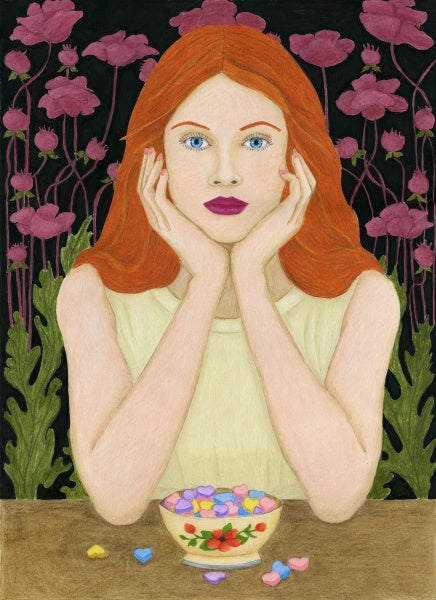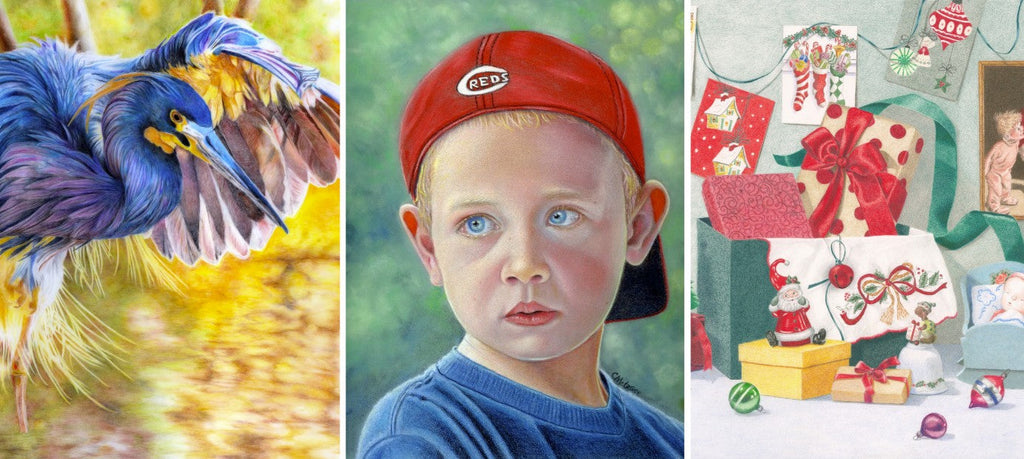Some Things I've Learned Along the Way
by Robin Manelis
About 3 years ago, I took Cynthia Knox’s Vivid Flowers in Colored Pencil Craftsy class. At that time, I can remember being blown away by the amazing colored pencil artwork I’d see online, in magazines and books. My dream was to become good enough to get published and to inspire others that way I was inspired.

My first drawing, Pickalicious, July, 2015
Drawing become a passion for me. I started to draw everyday and was amazed at the progress each new piece brought. Then, to my surprise, one day it happened. My piece, Mom’s Buttons, was published in the 2016 June issue of COLOR magazine. Since then, my artwork has been in several other publications and juried exhibitions.
Since Cynthia’s Cratsfy class, I’ve done about 55 pieces. It’s been truly a labor of love, one in which I’ve learned so much about drawing and even a little about myself. For instance, I never paid much attention to the beauty of botanicals. Now I can’t visit enough botanical gardens! Below are a few tips, tricks and habits I’ve picked up along the way.
I use Premier Prismacolor pencils and an X-ACTO ProX Classroom electric pencil sharpener. My pencils are stored in a homemade PVC pipe pencil holder. Keeping 3 extra pencils of each of the 150 colors on hand ensures that I will never run out of a color mid-project. As I start to use-up a pencil, I tape a new one to it. This allows me to continue to sharpen and use my pencils until they are very small stubs. For fun, I keep my tiny pencil stubs in a pretty glass jar!
My paper of choice is Strathmore Bristol Vellum 300 Series. At first, I used Strathmore Smooth paper but accidentally bought vellum once and decided I liked it better. Many of my best discoveries happen by accident like that!

44 drawings later - Pink Lilies, August, 2017
Recently I bought a Mini USB rechargeable vacuum that I love. It sits on my desk and works great for cleaning the pencil shavings that get everywhere and drive me crazy.
Workable fixative is handy for getting really dark values. After spraying a piece, I can deepen my dark values. I haven’t tried to lighten values but I’m thinking that will probably work as well.
Using my flatbed scanner, I scan my finished pieces at 600 dpi. If my piece is larger then my 12”x17” scanner, I can rotate the paper and create 4 separate scan files. Then I use Photoshop’s photo-merge feature to seamlessly merge the scans together.
Some other must have tools include: tracing paper, light-box and a tabletop easel.
Since I spend hours drawing everyday, I’ve become an audiobook junkie. Good thing they are readily available for free-download from the library! My current rate is 3 audiobooks per art piece.
Oh and most importantly, I keep a nice fluffy dog bed under my desk for my trusty side-kick and biggest fan!

Arizona Snowman, June 2017. On display at the Phoenix Sky Harbor Airport from October 28, 2017 – May 13, 2018.
As I mentioned, I had no idea how much I loved botanicals until I started taking photos of them in search of drawing subjects. The endless color palette, multitude of textures and shapes found in nature fascinates and inspires me. Sunlight also adds another level of interest and beauty. Now that I visit botanical gardens every chance I get, I literally have 1000's of reference photographs to choose from.
Using Photoshop, I can crop and adjust the colors and values of my photos. The select-color option allows me to darken and lighten individual colors increasing a photo’s value range. When cropping my images, I try to create interesting compositions sometimes using rule of thirds or the golden sections. Photoshop allows me to view a grid over my photos. For rule of thirds, I set the grid to 33% and for the golden sections to 12.5%. With the hue/saturation feature, I can adjust colors independently making some pop more and others less.
Finding a reference photo is the hardest part for me. After all, I’m about to spend 30+ hours working with the photo so it has to be just what I’m looking for!
Once the hard part of selecting a reference photo is done, I print it to size. For larger pieces, I print my reference photo in sections on separate pages and tape them together. Using my light table, I trace a rough contour drawing of my reference photo onto my drawing paper.
Before tracing, I cut my paper so that it is 1/4” bigger then my desired size creating an 1/8” margin. I attach my drawing paper to clayboard by running a solid piece of white artist tape along each margin. The tape creates even edges and the clayboard gives me a smooth, hard surface so that I can apply pressure when blending, without worrying about tearing or warping my paper.
The last step before beginning my drawing is to hold what I call a pencil audition. Going through my 150 Premier Prismacolor pencils that are lined up on my side table, I select all the colors that I think I will use. This narrows the playing field to about 30 pencils. Now I turn on my audiobook, my dog settles herself under my desk and I'm off to my happy place!
About Robin:

Robin Manelis is a self taught colored pencil artist that specializes in botanicals. The challenge of drawing the endless colors, textures and shapes found in nature fascinates and inspires her. She spends hours visiting botanical gardens gathering inspiration for her artwork. It is her hope to inspire others by sharing the incredible beauty of nature through her artwork.
See more at http://robinmanelis.com/





Comments (3)
Nice read.., love your work Robin..
john guiseppi - May 14, 2018Great read Robin and lovely to know more of your Journey xx Beautiful Botanical works!!
Robyn Garnet - May 14, 2018I love your work! I enjoy doing botanical colored pencil drawings as well, but am not that good yet. You said you spend 30 plus hours on your pictures. I spend sooooo long on mine! How do you manage to do such detailed pictures so quickly! Thank you so much for sharing information about your art with us! I am inspired by your pieces to work harder with my botanical pieces. Thank you!
Susan Miller - May 14, 2018